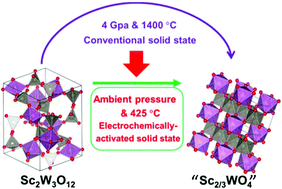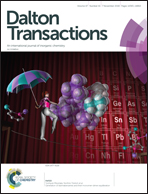Electrochemically activated solid synthesis: an alternative solid-state synthetic method†
Abstract
Solid-state synthesis is one of the most common synthetic methods in chemistry and is extensively used in lab-scale syntheses of advanced functional materials to ton-scale production of chemical compounds. It generally requires at least one or several high temperature and/or high-pressure steps, which makes production of compounds via solid-state methods very energy and time intensive. Consequently, there is a persistent economic and environmental incentive to identify less energy and time consuming synthetic pathways. Here, we present an alternative solid-state synthetic method, which utilizes structural changes, induced by an electrochemical “activation” step followed by a thermal treatment step. The method has been used to synthesize a Sc0.67WO4-type phase where Sc0.67WO4 has previously only been obtained at 1400 °C and 4 GPa for 1 h. Through our method the Sc0.67WO4-type phase has been prepared at only 600 °C and ambient pressure. Experimental factors that influence phase formation from the electrochemical perspective are detailed. Overall, the method presented in this work appears to be able to generate the conditions for unusual and new phases to form and thus becomes another tool for synthetic solid-state chemists. This in turn permits the exploration of a larger synthetic parameter space.



 Please wait while we load your content...
Please wait while we load your content...